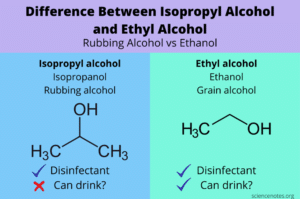Rubbing alcohol is an example of how not all alcohol is the same. Ingestion of rubbing alcohol is the second most common kind of alcohol poisoning and the most toxic. During the early years of the COVID-19 pandemic, the FDA had to loosen restrictions on who could supply hand sanitizers (which may contain isopropanol or denatured alcohol – both called “rubbing alcohol”), making it easier than ever to obtain. Most cases of poisoning are accidental, but some people drink it as a substitute for ethanol (the type of alcohol found in alcoholic drinks). Rubbing alcohol is not a substitute for an alcoholic beverage.
What is Rubbing Alcohol?
Rubbing alcohol is the kind you find in your medicine cabinet or in the first aid section at the local pharmacy or grocery store. In some countries, it is called surgical spirits or methylated spirits. Both denatured alcohol and isopropanol are often found in cleaning products and disinfectants. They are different to the type of alcohol found in alcoholic beverages (ethanol).
Isopropyl alcohol is as clear as water, but has a strong odor similar to acetone. Denatured alcohol can be clear or colored with dyes and is usually a mix of ethyl alcohol and other toxic chemicals, most commonly the extremely toxic methanol (which is also used in making formaldehyde). The term “rubbing alcohol”, used in the context of a medical disinfectant, can mean either of these two forms of alcohol, but is more often isopropanol in the US.
Rubbing Alcohol is Not Safe to Drink
Is rubbing alcohol intoxicating? Yes. Should you drink it? No.
You should NOT drink it. The type of alcohol in rubbing alcohol is isopropyl alcohol or ethyl alcohol with toxic additions like methanol (“denatured alcohol”), whereas the type of alcohol in consumable alcoholic beverages is pure ethanol or ethyl alcohol. Isopropyl and unadulterated ethyl are both alcohols, but have a very different chemical make-up.
Isopropyl and denatured alcohol are never supposed to be ingested. If you or someone else drinks even a small amount call 911 and the American Association of Poison Control at 1-800-222-1222. If possible, before calling, know how much was swallowed, when it happened, the age and weight of the person who drank it and the brand of the product swallowed. Do not induce vomiting as it may cause choking and ingested rubbing alcohol is caustic and damages the person’s throat and mouth when vomiting. If the person is already vomiting make sure they sit up or lie on their side. Do not leave an unconscious person alone.
Reasons for Drinking Rubbing Alcohol
Rubbing alcohol may be cheap and easy to get – making it easy to abuse. Even when you may not legally be able to purchase ethanol, you may be able to get medical disinfectants. The higher percentage of alcohol in it intoxicates the body at a level too high to process. Unlike the lower percentages of ethanol in alcoholic beverages, rubbing alcohol’s levels are very dangerous. Rubbing alcohol is made to kill microorganisms and disinfect wounds.
It is not meant as a drink and is not an “alternative” to alcohol. Some reasons for drinking rubbing alcohol include: by mistake, as a form of experimentation or out of desperation. It is important to remember that, whatever the motivation, rubbing alcohol is never safe for consumption.
Drinking Rubbing Alcohol is Dangerous
For those wondering why you shouldn’t drink rubbing alcohol to get drunk, it’s important to understand the consequences.
One problem is that the body absorbs this alcohol faster than the alcohol in liquor. It absorbs up to 80 percent in just 30 minutes. This doesn’t give your liver enough time to process and detoxify the alcohol before it goes into your bloodstream. Even a small amount can result in alcohol poisoning and death.
The next risk is the potency of isopropyl alcohol, which is much higher than ethanol. Isopropanol alcohol is typically about 70 percent alcohol by volume. It’s so high that your liver can only process a small amount, about 200 milliliters for adults and much less for children. For example, since the Covid-19 pandemic, the National Poison Data System has recorded more accidental deaths in children under 5 years old, who unknowingly drank hand sanitizers (many of which contain isopropanol); even a little is too much.
Drinking high quantities of any alcohol is potentially dangerous; this includes what you get at the liquor store. Since isopropyl alcohol is more potent and absorbs faster, though, it takes much less of it to kill you.
Rubbing Alcohol Cannot be Drunk – Even if it is Diluted with Water
You may be thinking that if one of the problems with drinking rubbing alcohol is that it is too strong (70 percent by volume). The Alcohol Content Database lists, for example, wines as normally containing 8-12 percent alcohol. So, why shouldn’t you just add water to rubbing alcohol until it has a “safer” concentration?
There is no “safe” concentration of rubbing alcohol to drink. At the root of it, rubbing alcohol and drinking alcohol are made up of different molecules: isopropanol and ethanol. Yes, the high concentration of alcohol in rubbing alcohol is a major concern and is one of the dangerous ways it overwhelms your system. However, diluting rubbing alcohol won’t change its molecular structure – it is still isopropanol, not ethanol.
Rubbing alcohol poisons your body because of what the type of alcohol in it becomes. Your body turns isopropyl alcohol into acetone (often used as nail polish remover and a paint thinner). Acetone is a powerful central nervous system depressant. It lowers your blood pressure and body temperature and can cause the cardiac and respiratory systems to collapse. Forty-five percent of people who die from rubbing alcohol poisoning do so from hypotension (low blood pressure).
Symptoms of Rubbing Alcohol Poisoning
To be safe, you should also be aware of the symptoms of alcohol poisoning such as:
- Dizziness
- Low blood pressure
- Stomach pain
- Nausea
- Vomiting
- Low body temperature
- Burning in your throat
- Signs of intoxication – such as slurring, impaired balance and confusion
If you see some or all of these signs in someone else or experience them yourself, you need to get medical help immediately. Someone with isopropyl alcohol poisoning may need their stomach pumped and/or dialysis to remove the remaining alcohol and the acetone from their blood. Drinking rubbing alcohol will also make you very dehydrated, so IV fluids are necessary. Oxygen therapy will help to remove the acetone from the lungs, as well. Alcohol poisoning is very serious and increased intoxication is not worth the risk.
Is Drinking Rubbing Alcohol a Sign of Alcohol Addiction?
Drinking rubbing alcohol may be a sign of an alcohol use disorder (AUD) that requires treatment. Some of the signs that the Diagnostic and Statistical Manual 5 (DSM-5) uses to help clinicians to diagnose AUD include: whether the person drinks more or for longer than they intended, continued drinking despite the negative aftereffects and if they could not stop drinking, even though they wanted to. These all apply to drinking rubbing alcohol as well as normal liquor.
A person may turn to rubbing alcohol because they needed to get a higher dosage of alcohol to get the same level of intoxication, as they have built up a tolerance to ethanol. They may also drink it when they have no liquor left and need more to avoid withdrawal symptoms. It is important to understand why a person drank rubbing alcohol before automatically assigning them a diagnosis of AUD. There are various stages of alcohol abuse. Not all of them mean that a person has AUD, but they may be warning signs that a person is on their way to developing it.
Seeking Treatment for Alcohol Use Disorder
If you or a loved one has ever considered drinking rubbing alcohol because of an alcohol addiction or alcohol dependency, please seek treatment. You do not have to struggle alone and there is always hope.
At Lakeview Health, we offer a variety of addiction treatment programs for those struggling with alcohol addiction. These programs include:
- Medical detox
- Residential treatment program
- Inpatient care
- Partial hospitalization program
- Intensive outpatient program (IOP)
- Aftercare program
We also provide gender-responsive programs and have family therapy programs as well.
- Learn more about alcohol use disorder
- Learn more about alcohol addiction treatment
- Learn more about the alcohol detox process





